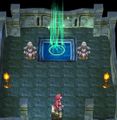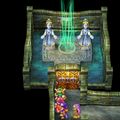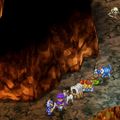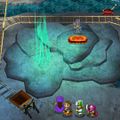Healing Spring: Difference between revisions
Antiyonder (talk | contribs) No edit summary |
Antiyonder (talk | contribs) No edit summary |
||
| Line 1: | Line 1: | ||
[[Image:DQXI Cryptic Crypt Fountain.jpg|thumb|right|300px|A healing spring in ''Dragon Quest XI''.]] | [[Image:DQXI Cryptic Crypt Fountain.jpg|thumb|right|300px|A healing spring in ''Dragon Quest XI''.]] | ||
A '''Healing Spring''' (回復の泉, ''Kaifuku no izumi'', lit. Fountain of Recovery) is a recurring gameplay element in the {{DQSeries}}. It is a location typically found within a dungeon where the player's [[party]] may walk onto and fully restore their {{HP}} and {{MP}}. Healing Springs typically do not revive deceased characters or cure status ailments. | A '''Healing Spring''' (回復の泉, ''Kaifuku no izumi'', lit. Fountain of Recovery) is a recurring gameplay element in the {{DQSeries}}. It is a location typically found within a dungeon where the player's [[party]] may walk onto and fully restore their {{HP}} and {{MP}}. | ||
Healing Springs typically do not revive deceased characters or cure status ailments. | |||
In some games, there are also magic circles of light or stone tablets found in certain dungeons that will recover the [[party]]'s {{HP}} and {{MP}} as well, essentially fulfilling the same role as a healing spring. | In some games, there are also magic circles of light or stone tablets found in certain dungeons that will recover the [[party]]'s {{HP}} and {{MP}} as well, essentially fulfilling the same role as a healing spring. | ||
| Line 16: | Line 18: | ||
*[[Inside the Time Frame]] ({{Dragon Quest VII}}) | *[[Inside the Time Frame]] ({{Dragon Quest VII}}) | ||
*[[Swordsman's Labyrinth]] ({{Dragon Quest VIII}}) | *[[Swordsman's Labyrinth]] ({{Dragon Quest VIII}}) | ||
* | *{{Dark Ruins}} ({{Dragon Quest VIII}}) | ||
*[[Memories Lane]] ({{Dragon Quest VIII}}) | *[[Memories Lane]] ({{Dragon Quest VIII}}) | ||
*[[Gortress]] ({{Dragon Quest IX}}) | *[[Gortress]] ({{Dragon Quest IX}}) | ||
| Line 32: | Line 34: | ||
DQ V Android Mount Magmageddon 1.jpg|The Healing Spring in [[Mount Magmageddon]] from {{V}}. | DQ V Android Mount Magmageddon 1.jpg|The Healing Spring in [[Mount Magmageddon]] from {{V}}. | ||
DQ V Android Diggery Pokery Healing Spring.jpg|The Healing Spring in [[Diggery Pokery]] from {{V}}. | DQ V Android Diggery Pokery Healing Spring.jpg|The Healing Spring in [[Diggery Pokery]] from {{V}}. | ||
DQ VIII Android Dark Ruins Healing Spring.jpg|The Healing Spring in the {{Dark Ruins}} from {{VIII}}. | |||
DQXI Healing Spring.png|Map icon from {{XI}}. | DQXI Healing Spring.png|Map icon from {{XI}}. | ||
</gallery></center> | </gallery></center> | ||
Revision as of 09:29, 8 January 2023
A Healing Spring (回復の泉, Kaifuku no izumi, lit. Fountain of Recovery) is a recurring gameplay element in the Dragon Quest series. It is a location typically found within a dungeon where the player's party may walk onto and fully restore their HP and MP.
Healing Springs typically do not revive deceased characters or cure status ailments.
In some games, there are also magic circles of light or stone tablets found in certain dungeons that will recover the party's HP and MP as well, essentially fulfilling the same role as a healing spring.
Locations
- Underground Lake (Dragon Quest III)
- Cloudsgate Citadel (Remake of Dragon Quest III)
- Loch Tur (Dragon Quest IV)
- Royal Crypt (Dragon Quest IV)
- Mount Magmageddon (Dragon Quest V)
- Knightmare Towers (Dragon Quest V)
- Diggery Pokery (Dragon Quest V)
- Burnmont (Dragon Quest VII)
- Inside the Time Frame (Dragon Quest VII)
- Swordsman's Labyrinth (Dragon Quest VIII)
- Dark Ruins (Dragon Quest VIII)
- Memories Lane (Dragon Quest VIII)
- Gortress (Dragon Quest IX)
- The Cryptic Crypt (Dragon Quest XI)
- The Cruel Crypt (Dragon Quest XI)
See also
Gallery
The Healing Spring in the Underground Lake from III.
The Healing Spring in the Royal Crypt from IV.
The Healing Spring in Mount Magmageddon from V.
The Healing Spring in Diggery Pokery from V.
The Healing Spring in the Dark Ruins from VIII.
Map icon from XI.
|
|
This article is a stub. You can help by expanding it. |







